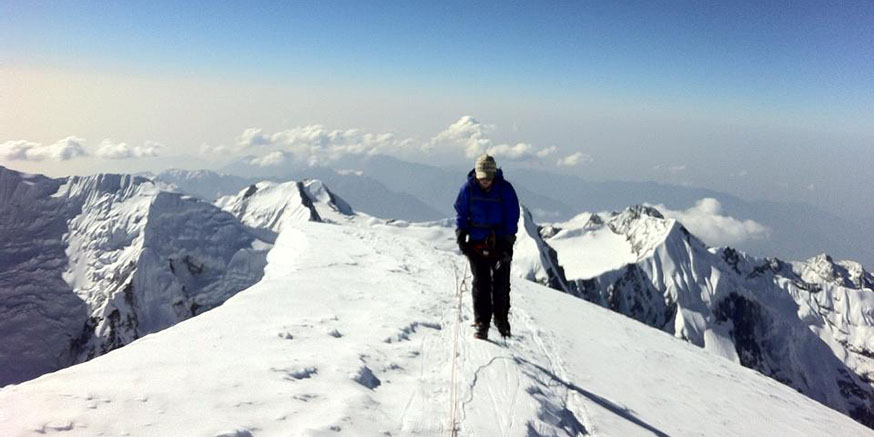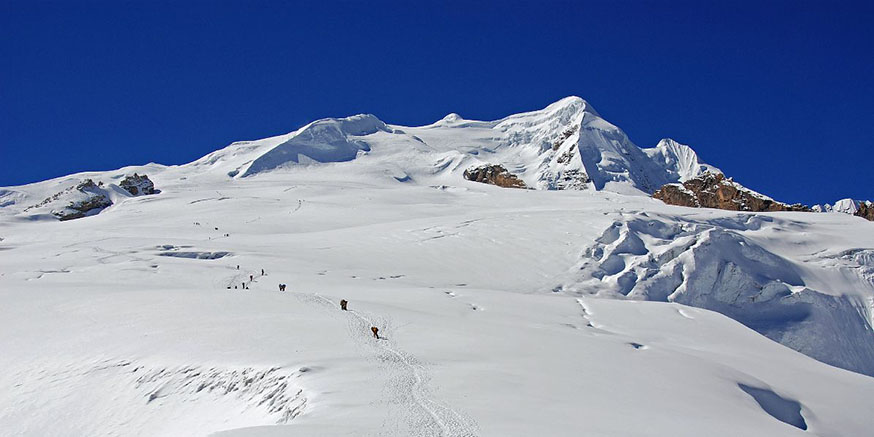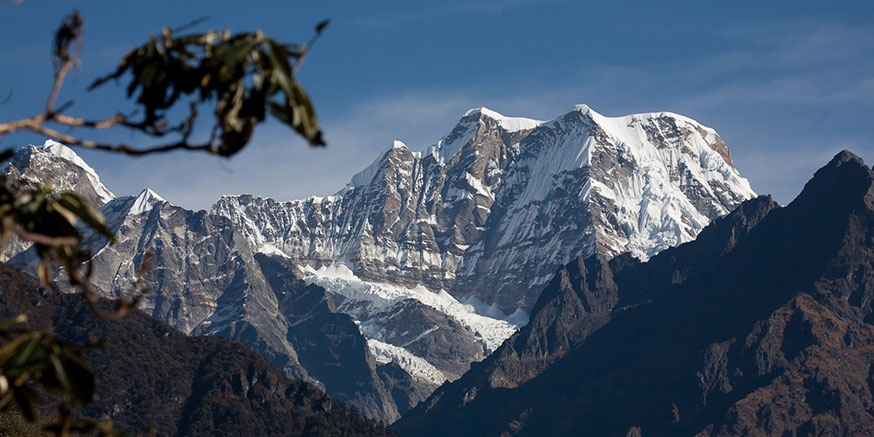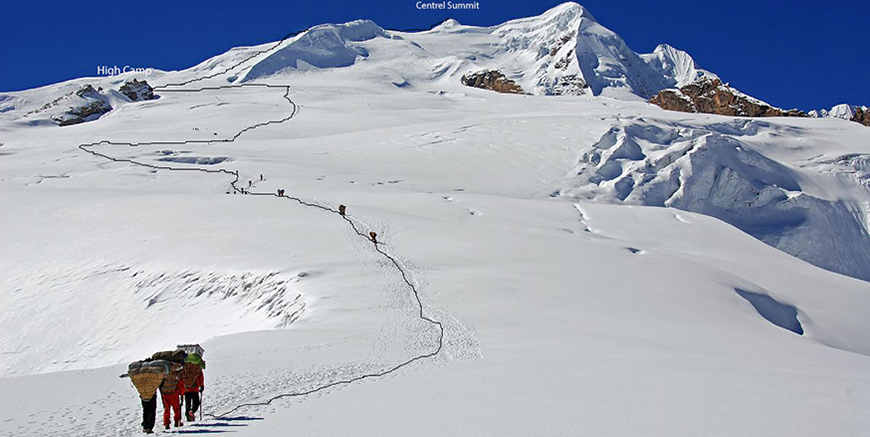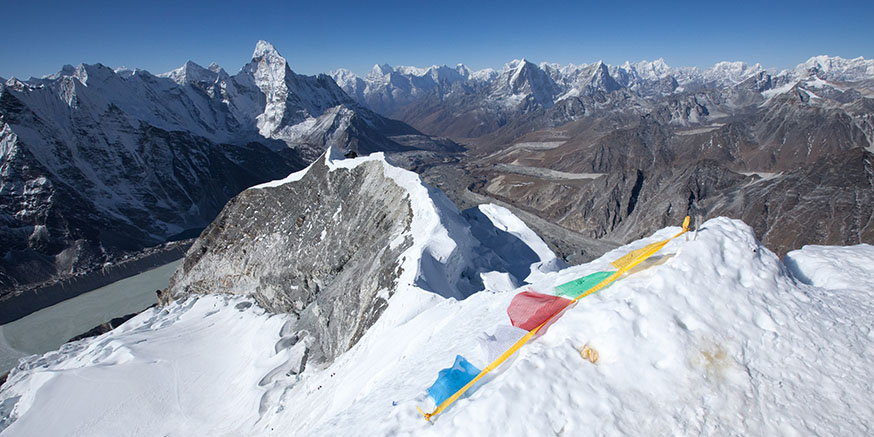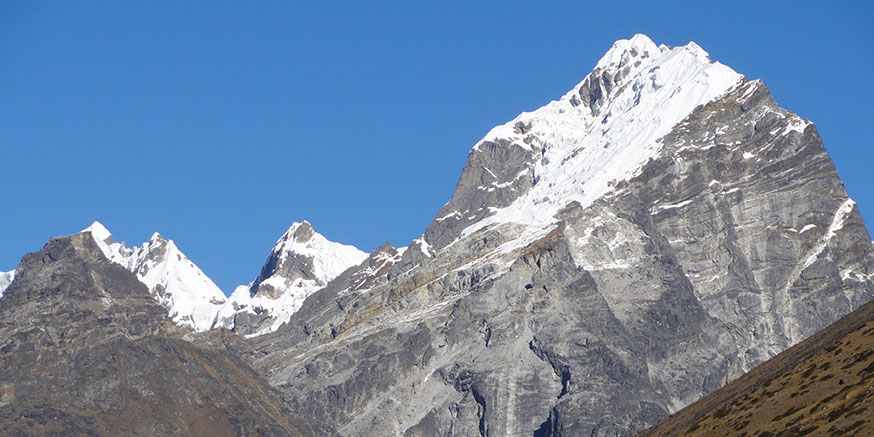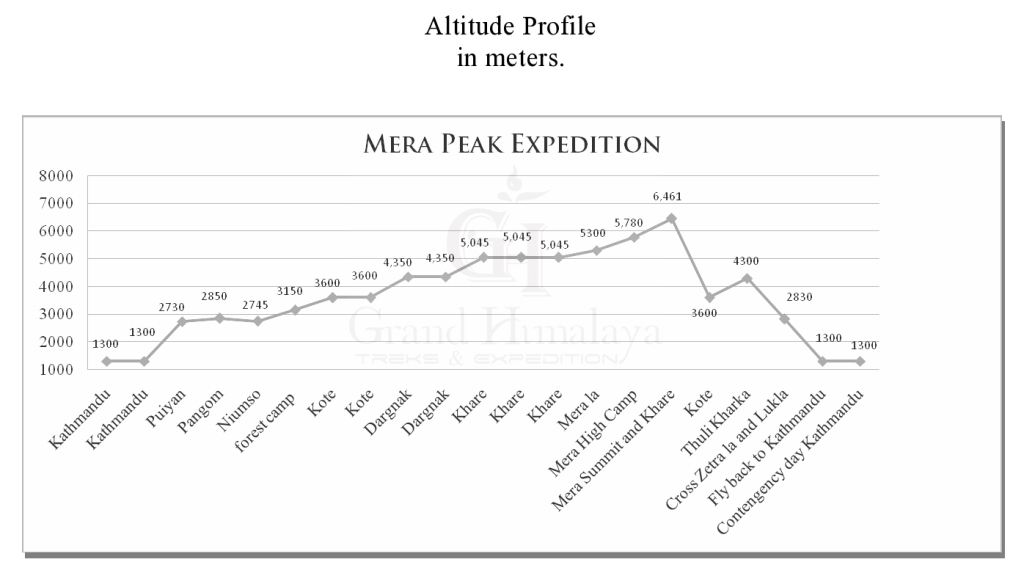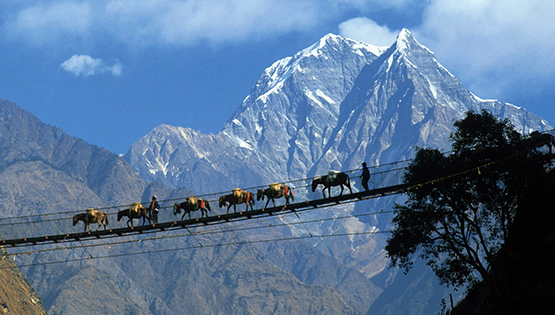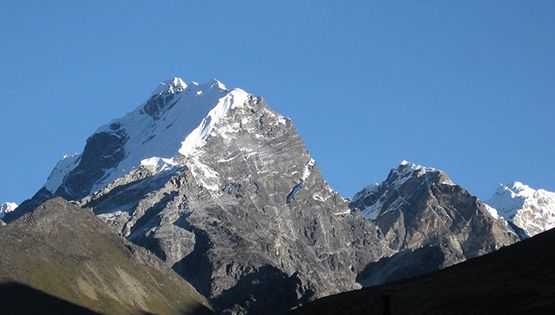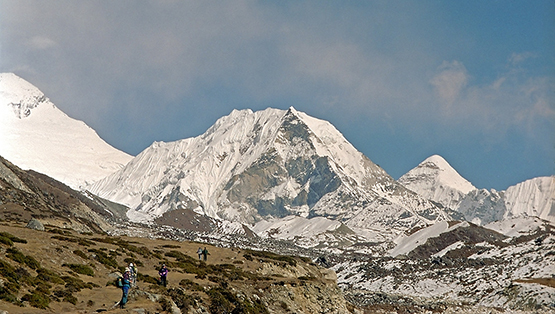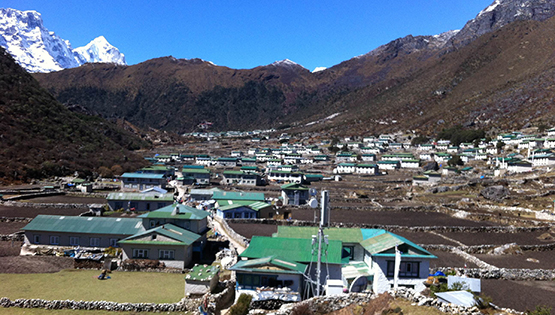The bulk of Mera, considered to be one of highest Nepal's permitted trekking peaks, rise to the south of Everest and dominates the watershed between the wild and heavily waded valleys of the Hinku and Hongu Drangkas. Mera (Peak) is a chance to venture into a little visited and as yet unspoiled region of Nepal where the hillsides are still densely forested and a need to be self-sufficient is essential. There is also, of course, the pleasure of going above 21,000 feet. Both the Hongu and Hinku valleys remain uninhabited although there are Kharka in the Upper Hinku basin where Sherpa from the South, near Pangkongma, graze their animals during the grass- growing monsoon. The upper Hongu Basin is truly a mountain wilderness, a place of massive moraines, glacial lakes and spectacular peaks that include Charmlang and Baruntse. Additionally, it offers some of the most amazing mountain landscape, pristine forest, and high altitude climbing in the world. We start this climb with a hair-raising flight into the small town of Lukla at 2,800 m (9,184 ft). From there it is a six-day trek, with plenty of acclimatization days to keep us fit at our ever-increasing altitude, through some of Nepal's most pristine Rhododendron, oak, silver fir and birch forests, past beautiful alpine lakes, and finally up to the foot of Mera Glacier where well establish base camp. We will set up two more high camps, the first over 300 m above B.C. on the Mera Glacier, and the second after we cross the Mera crevasse field at 5,800 m. From here it is a steady and steep climb to reach the summit, with awe-inspiring views of Kanchenjunga and Makalu to the east, Everest and Lhotse to the north, Ama Dablam and Cho-Oyu to the west. Tea houses in this area now continuously developing each season and it is absolutely possible to complete this trip with less expedition supplies carried by porters staying and eating in tea houses apart from two nights stay in tent at Mera high camp. However we also offer those who wish to continue on camping experience on request. Please email us on grandhimalayaexpedition@gmail.com or send us a text on WhatsApp number +977 9841427399 for detailed Trip Notes. Published trip cost is based on single travelers, please contact us for group cost. We are flexible on offering with customized trip for those who have limited time.
A very warm welcome to the Kingdom of Himalayas. Upon your arrival at the Tribhuvan international airport our representative welcomes you and assists you transfer to your hotel in Kathmandu. After time to get refreshed, evening you'll meet and transfer for welcome dinner in one of the typical Nepalese restaurant in the heart of Kathmandu i.e. Utsav or Nepali Chula (Kitchen). Here you will not simply experience the traditional Nepalese dish but will be entertained with Nepalese traditional dance and folk songs. After the dinner, you will be transferred back to your respective hotel.
Kathmandu is the historical and cultural heart of Nepal and has been a popular destination for tourists ever since Nepal opened its doors to visitors. The city presents a wonderful mix of Hinduism, Tibetan Buddhism and Western influence in the Valley. Bauddhanath: Stupa with its 130 ft. dome. One of the world's largest Stupa, Bouddha is generally acknowledged to be the most important Tibetan Buddhist monument outside Tibet. Tibetans simply call it CHORTEN CHEMPO "Great Stupa". It has now become the Mecca of Tibetan exiles in Nepal. Walking around Bouddhnath one often fins men wearing long braids wrapped around their heads. Many of these pilgrims carry their own prayer wheels, which they spin incessantly. Pupshupatinath Temple: Pashupatinath is considered one of the holiest shrines of all the Hindu temples. The temple has remained the presiding deity of ruling Nepalese Royalty. Located on the banks of the Bagmati river, this two-tiered magnificent golden temple with four triple silver doorways is unique example of the Nepalese temple architecture. It is one of the largest Hindu temple complex in' South Asia with hundreds of Shiva lingams, shrines icons of various Hindu god and goddess insides. This temple site occupies an area of 281 hectors in total. The main entrance of this temple is in the western side facing a small street of Deopatan market. As non-Hindus are not allowed to enter this temple courtyard. They are advised to go on the other side of the river in the East to have a glimpse of the temple complex. In the middle of the spring (Feb. March) every year there occurs a festival called Shivaratri. The world Shivaratri means the holy night of Lord Shiva. On this day many devotees visit the Pashupati Nath temple and make the ceremonial fire. Most of the devotees spend the night offering prayers to Shiva. This festival attracts tens of thousands of pilgrims from India besides the locals. Historically pre-Christian era this temple seems to have its origin away back to the early Kirat period. Stone sculptures found in the vicinity support the antiquity of this place. This holy site is 6 km. east oil down town Kathmandu. Regular bus and taxi services are easily available from a city points. Swayambhunath: Three kilometres west of Kathmandu city complex locates the one of the world’s most glorious Buddhist Stupas, it is said to be 2000 years old. Visitors often call it "Monkey Temple". The main structure brick and clay which supports a lofty conical spire capped by a pinnacle of copper gilt. There are the all-seeing eyes of Lord Buddha on the four sides of spire. Being situated seventy meter above the level of valley, the hill of swayambhunath is a mosaic of small Stupas and pagoda temples. Aside, in front of the temple, one of the famous goddess with the shrine of Ajima called "Harati Mata" is there. This temple of goddess believes to be famous in the way of tantric. Both the stupa of Lord Buddha and temple of a goddess are surrounded by other temples and Tibetan monasteries. Being located in the top level of valley, this place is famous for visitors for sightseeing. After the city tour, your expedition guide or the company's manager will do the full briefing of the trek. They will also take the opportunity to check the members' personal equipment as the city bazaars and climbing shops will provide the last chance to correct any deficiencies.
Early morning after breakfast, we get transferred to domestic airport to fly to Lukla. After an adventurous 40-minute flight above breathtaking green and white mountains, we reach Tenzing-Hillary Airport at Lukla. This is one of the most beautiful air routes in the world culminating in a dramatic landing on a hillside surrounded by high mountains peaks. At the airport, we meet our other crew members. We get time to stroll around while the guide divides and manages baggage to be carried by porters. We start our trek down from Lukla. It will make sense to fly up to Lukla for acclimatization and walk down. We walk through the jungle down to Surke then a bit ahead we have lunch at Pakhapani or ahead nearby. Continuing ahead through many traditional villages, jungles, and hills, we gradually reach the vicinity of Paiya for the first night's camp. We see number of peaks from here such as Knogde Ri, Khatang, Tang Ragi Tu and other peaks above 7 thousand meters from Paiya. Overnight at Paiyun. Included meals: Breakfast, Lunch, Dinner
After breakfast, we march a little down until we reach wooden bridge and then carefully we have to go ahead through the slippery trail to cross Kari-La Hill (pass). We have our lunch near the stream and start up walking through the rhododendron and bamboo forests through the narrow mountain trail. Our cameras are ready with full charge to catch the outstanding views of Dudh-koshi River valley and Dudh Kund Himal before reaching the farming and trading village of Pangom for night's rest.
The trail descends the rock-strewn path leading to the rhododendron forest. We come across a lot of Mani walls through the trail. Passing again through hills, ridges, and teahouses we start downwards and have a snack and drink break at Sibuje village. Mesmerizing views of the south face of Mera Peak (6064m/19890) and Naulekh Peak awaiting our insight ahead. The trail zigzags through forested areas and then descends steeply. We experience the most interesting and charming feelings as we walk past forests of pine and rhododendron to reach Niumso where we camp for the night's rest. After the lunch at the camp, you can enjoy your leisure afternoon listening to the whispering of the birds and murmuring of the stream.
After breakfast, we start up through a steep and slope trail through narrow and typical mountain trail, a bit complicated ahead through rhododendron and bamboo forests, we pass in the course of landslides and down we reach to the stream. By the side of the crystal clear stream we have our lunch today. Straight ahead and up through the rhododendron forests we may encounter wild animals if we are lucky. A little down through the bamboo jungle and past a nice stone cave by the side of a river, we will camp for the night's rest. It's an amazing site to witness the porters camp firing and resting for the night under the cave.
Chirping birds wake us up early in the morning. We start after breakfast and reach a fine vantage point of the Hinku Valley where we line around in the splendour of nature surrounding us. Straight through the bamboo and pine forest in the narrow trails while enjoying the views of Mera and the Hinku Valley, there is possibility of encountering with mountain wild animals like sloth bear, jungle cat, etc., among the tall pine trees. Past Thashing Dingma we find shops and teahouses where we'll have lunch. We continue ahead by the ridge of the river in the Hinku valley all the way up and reach Kote where we will have the night's rest in a camp. Today would be the day we meet the main trekking trail to Mera Peak and we expected to see the usual blend of trekkers from all over the world.
It's indeed worth having an extra day at Kote after few days of continuous and strenuous walk through the woods. We can dry out our wet gears if there is any for instance, sleeping bag, and the members could give their laundries to the kitchen crews. A small amount of tips to do your laundries is very much appreciated. Members can take a hot bucket shower after breakfast and can go for a little hike before lunch.
Today is another short-trek day in which we trek along the ridge of the Hinku Khola in the shadow of Mera Peak. We take lunch at Gondishung, the summer herders' settlement in the west bank of the Hinku Dragnak. Beyond Gondishung we pass a 200 year-old Lungsumgba Gompa where we can find Mera peak scripted in rock along with its route to reach Mera. We will pray for our successful ascent of Mera Peak in the boulder of the Gompa offering incense. A short walk takes us to Dargnak, which is a summer grazing area with the primitive lodges and shops.
Today is our rest day. It is not recommend to stay idle although it is a rest day instead we have to stay active to be ready for next day's adventure. So after breakfast, we hike for about 3 hours up to Charpate Himal Glacier. Seen very close from the Dargnak, Charpate Himal (Kyasar peak) is regarded holy by the Sherpa community and is worshiped by traditional Sherpas of the mountains. We will observe Mera North very close and outstanding from here. After an hour's pleasant hike downwards, we will be back at Dargnak.
We follow the lateral moraine of Dig Glacier to Dig Kharka, which offers spectacular views of Charpate Himal. The trail climbs through moraines and to the snout of the Hinku Nup and Shar Glaciers and then climbs more steeply to our camping spot at Khare. The camping experience at Khare is something that would cherish us throughout our life. It is pleasure to view beautiful North face of Mera Peak from our campsite at Khare.
After the breakfast the sherpas will once again do the through assessment of the team's climbing gear, high foods, high pots and stoves, and repack them. The members accompanied by some sherpas, will do the final acclimatization hike up the Khare Ri (Peak) which is around 300 meters higher than Khare. The view towards the Mt. Amadablam, Mt. Khangtega, Peak 41, Kyashar himal (Mountain Range), and the sprawling summits of Mera peak is simply marvellous.
Today we'll take a short hike of around an hour towards the Mera La and we are taking with us all our personal climbing equipments. The sherpas will do some fix line on the snout of Mera La glacier and teach you some useful snow skills. The snow skills cover the appropriate handling of climbing equipments and travelling in a glacier on a rope. The sherpas will teach you the technique of using Jumar and Abseil device on a fix line, as well as walking on glacier terrains with your climbing boots and crampons. You will certainly enjoy your snow skills training and they are worthwhile having. We come back to Khare for the late lunch and for the overnight.
Today you will travel a short distance, slowly ascending up onto Mera glacier. The climb is initially steep, but flattens out as you reach the crest of the glacier. You will traverse a long flat path on top of the glacier as you make your way to the pass, called Mera La (5,350m/ 17552 ft). From here, the views are stunning. Crevasse fields gently stretch out in front of the pass and you are literally enclosed by a ring of jagged peaks and blue-green glaciers. The remaining route up to the summit of Mera Peak is clearly visible.
This day you trek a gradually ascending path all the way. This area is covered by ice glacier. The views make you speechless as you enjoy Everest, Makalu, Baruntse, Kusum Khangkaru and many other mountains and peaks in panorama. Moreover, you feel chilled by the magnificent views of Mera Glacier.
This is really a big day. The crew wakes up around 3 a.m. for preparation and comes to your tent with a wake up tea at half pass 3. The group puts on crampons and rope and set up for special journey to the summit. If we are a well-acclimatized group, it takes around 4-6 hours to reach the summit of Mera central. From the summit, we can see the spectacular views of 5 eight thousand meters peak that includes Mt. Everest (8,848m/29,021ft), Mt. Cho-Oyu (8,210m/26,928ft), Mt. Lhotse (8,516m/27,935ft), Mt. Makalu (8,463m/27,760ft), and Mt. Kangchenjunga (8,586m/28,165ft) in the far east. Some of the other mountains that can be seen are Mt. Nuptse (7,855m/25,765ft), Chamlang (7,319m/24,010ft), Baruntse (7 ,129m 23,383ft), Ama Dablam (6,812m/22,343ft), Kangtega (6,779m/22,235) and many peaks over six thousanders too. After achieving the summit, we retrace our steps down to high camp. After having a rest accompanied by some hot soups/tea at the high camp, we will continue down to Mera la and on to Khare for the night's rest. Like every other peak summit day, the summit day of Mera Peak is also long and strenuous, but undoubtedly worthwhile.
Descend quickly back to the Hinku valley to Kote where the climb will be celebrated again.
Today the trek initially climbs fairly steeply through the lush forest on the west side of the Hinku Valley to reach the camp, Thuli Kharka. Along the way there are good views of the Mera peaks and the massive Hinku valley.
Two hours up from Thuli Kharka cross the final pass of the trek at Zetra La (4600m), which separates the Khumbu from the Hinku Valley. Under fresh snow this pass can be quite difficult, especially for the porters. The views across the Dudh Koshi towards Karyolung and the Lumding Himal are impressive, as is the view across the rolling foothills east of the Hinku Valley. After crossing the pass the vista opens to beautiful views of the Lukla valley and the stunning peaks of Cho-Oyu, and many others are a treat for the eyes and the camera. From the pass, descend gently to Chutanga village where we stop for the lunch and then the remainder of the day is spent on a well-defined trail descending on a lovely walk through the rhododendron forest. On this final night we will celebrate with the crew and group in traditional style, so be prepared to sing and dance accompanied by some local wine and bear (Chang and Rakshi). Overnight at lodge.
Saying final goodbye to our porters, we fly back to Kathmandu after our long mountain journey. The flight time to Kathmandu are scheduled in the morning normally because Lukla suffers a lot of wind afternoon. Sometime the flight time can be delayed due to bad weather and other reasons. The early morning flight drops us at Kathmandu and the Getaway Himalaya van or coach will transfer you to the hotel. You may have time to relax after long journey and take back your breath and rest at your hotel with ending your Himalayan expedition. Remember, we will be hosting a fantastic celebration dinner together in the finest restaurant in Thamel, in occasion of successfully completing your Mera peak climbing!
Rest and relax at the hotel after such long a wonderful trip. The day is also reserved as a contingency day due to flight delays or other unforeseen conditions. For those eager to see as much of Kathmandu as possible, an early start is worthwhile to visit the temples of Pashupatinath and Swayambhunath and districts of Bhaktapur and Patan. Durbar Square is also on the essential list, as is the shopping area of Thamel. In the evening you can have your last night in Nepal, enjoying the Nepali cultural dinner show or go out to Thamel.
Today is free or last minute shopping for souvenirs or gift to your family, friends or relatives for you until your departure flight/drive or to commence any extra trips or activities you may have booked with us. If departing, you'll be transferred to the International Airport for your departure flight to your onwards destination.
- 4 night hotel accommodation in Kathmandu in a 4 star category hotel. Breakfast is included. Accommodation is on a twin share basis.
- Mera peak 6476m climbing permit for team member.
- Makalu Barun National park entry fees, TIMS Card & all government taxes.
- Return Domestic flight ticket KTM-LUKLA-KTM (In Twin Otter) all guests, one local Sherpa guide (No Helicopters Flight cost included). Please be advised, USD:500/-Per person extra cost for chartering a Helicopter flight in case of bad weather disturbance on fixed wing Twin Otter flights IN/OUT of Lukla.
- all Meals, drinks and accommodation on the trek in the tea houses during the trekking period. (Breakfast, Lunch, Dinner, Tea/Coffee) But no alcoholic beverage.
- All pickup and drop transportation from airport to airport both domestic & international airports plus domestic airport .
- One day guided city sightseeing tour in around Kathmandu (largest Buddhist stupa in the world at Bouddha Nath and the most important Hindu temple in the valley at Pasupati Nath). Transportation, fully licensed tour guide and entry fees included.
- An experienced Sherpa guide who knows the area, mountain, local people and culture very well.
- Additional assistant guide if needed, depending on the number of guest, our cost is based on (4:1 ratio). Guest number goes up beyond 4, and then we will provide a additional assistant guide from Lukla.
- 1:1 ratio porters to carry your personal climbing gear plus for a local guide's equipment (from Lukla-Lukla)
- All necessary climbing hardware gear rope/Ice and snow anchor.
- Quality high altitude food.
- Necessary number of EPI gas with burner, pots/pan.
- Good quality Two men tent with sleeping mattress, tents on sharing between two person at Mera High camp.
- Group kitchen tent for cooking meals for the entire team and for storing the supplies during the trip.
- Camping trek biodegradable and non-biodegradable garbage disposal fee to the Makalu Barun National Part Sagarmatha Pollution Control Committee (SPCC).
- Farewell dinner in Kathmandu after the trek, local cultural music and Dance show in a well reputed restaurant, Bhojan Griha/Nepali Chula/Utsav with guide/staff (TBC)
- Insurance for climbing Sherpa coverage of accidental death, medical expenses and emergency helicopter evacuation cost.
- All local staff & porters properly insured & equipped.
- 1 (4 Liter) bottle of "SUMMIT" Oxygen & mask regulator set for medical use only.
- A Sat phone set with sufficient balance on it will be provided by GHTE (only for emergency use during the trip)
- A regular/simple cell phone with local SIM Card & charger cable will be provided in the team during the trip. Guest will be requested to return this to Grand Himalaya staff at the end of the trip.
- One locally made water Proof Duffel bag with your Name & Grand Himalaya's Logo on it will be provided by us for the Trek, it is yours so you may take it back to home with you or return to us as you wish.
- Comprehensive First Aid Kit only for local staff.
- International & home country domestic airfares, transfers en route & excess baggage.
- Your personal insurance: Medical, mountain rescue cover and repatriation is obligatory.
- Your personal expenses e. g phone calls, Wireless internet (Wi-Fi), cost for electronic devices charging facility in the tea houses, charges for showers in tea houses,
- Main meals (Lunch & Dinner) in Kathmandu apart from celebration meal in Kathmandu after the trip with local staff).
- Your Nepal entry visa fee (US$40 available on entry) Valid for 30 days.
- Tipping to the guide & local staff (allow up to $200-250/- per guest)
- Excess baggage above 15 kg will be extra charged US$1.5 per kg. All guests are kindly requested to be prepared cash in Nepali currency to pay airlines company at the domestic airport for excess depending on weight you have.
- Extra night accommodation in Kathmandu because of early arrival, late departure, early return from mountain (due to unforeseen circumstance) than the scheduled itinerary.
- Personal climbing/Trekking gear as list provided.
- All guests are kindly requested to bring your own First Aid Kit with sufficient medication supplies for the trek.
| # | Start Date | End Date | Trip Cost | Availability | Booking |
|---|---|---|---|---|---|
| 1 | 28 MAR 2025 | 18 APR 2025 | USD3000/PERSON | Available | Book Now |
| 2 | 3 MAY 2025 | 24 MAY 2025 | USD3000/PERSON | Available | Book Now |
| 3 | 10 MAR 2025 | 31 MAR 2025 | USD3000/PERSON | Available | Book Now |
| 4 | 17 OCT 2025 | 7 NOV 2025 | USD300/PERSON | Available | Book Now |
| 5 | 28 SEP 2025 | 19 OCT 2025 | USD3000/PERSON | Available | Book Now |
| 6 | 20 APR 2025 | 11 MAY 2025 | USD3000/PERSON | Available | Book Now |
| 7 | 15 APR 2025 | 6 MAY 2025 | USD3000/PERSON | Available | Book Now |
